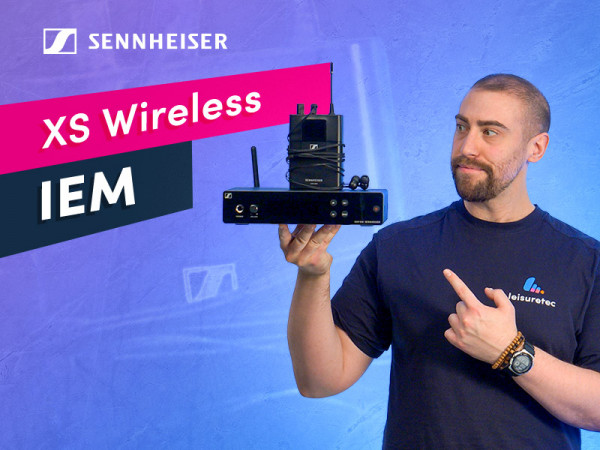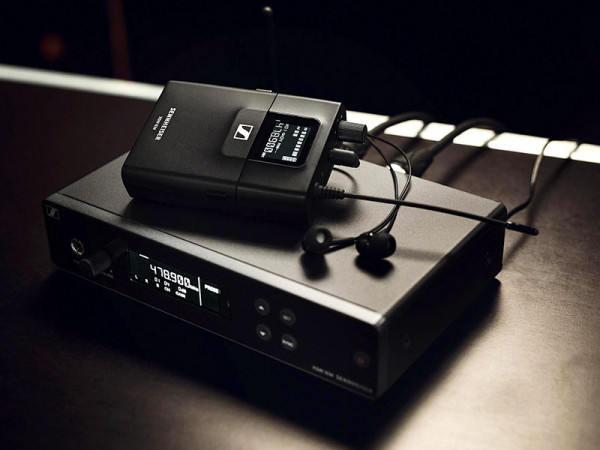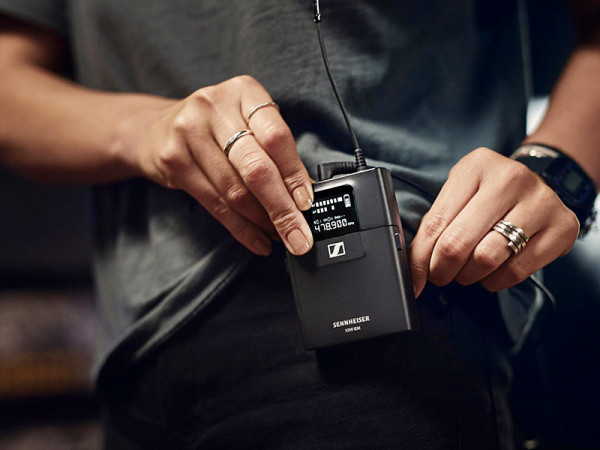Sennheiser Launch XS Wireless IEM
Posted on: 26th April 2022
Sennheiser have added a brand new In-ear Monitoring system to their entry level XS Wireless range. The XSW IEM is designed around simplicity and ease of use, with professional audio features that make it a must have for hire and events, as well as non-technical end users. Sennheiser have added a brand new In-ear Monitoring system to their entry level XS Wireless range. The XSW IEM is designed around simplicity and ease of use, with professional audio features that make it a must have for hire and events, as well as non-technical end users. Check out our Product Profile below where we cover all the angles on this exciting new product.
Who’s it for?
Typically used by bands and performers in studios and on stage, in-ear monitors are becoming an increasing popular alternative to stage monitor speakers. This is largely down to the increased fidelity and control over the audio you hear, but also the flexibility to move about the stage without worrying about moving away from your monitor speakers or noisying up the stage with lots of different outloud mixes.
With XSW IEM, Sennheiser’s simplified the wireless monitoring experience, with a basic yet surprisingly flexible feature set making personal monitoring more accessible to everyone. This system is ideal for schools, theatres and houses of worship, or as a low-cost workhorse for hire and events companies renting out to bands and small event spaces.
Unboxing
Included in the box you get a stereo transmitter, beltpack receiver, 2 batteries, IE 4 headphones, DC power brick and adapters, antenna and finally a rack mount kit. Everything you need to get started straight out of the box. Like with EW-D Sennheiser have continued to pare down the amount of plastic packaging which is always great.
The IE 4’s you get with XSW IEM are a great low-key headphone for in-ear monitoring, but thanks to the standard 3.5mm jack there’s nothing stopping you from using your favourite Sennheiser can’s or upgrading to the more premium IE PRO range for increased fidelity and a more secure fit for those high energy performances.
Build and Physical
As for build quality, it’s pretty much exactly what you’d expect from Sennheiser.
Bodypack
The bodypack receiver is nice and light at around 150g with a full plastic shell and battery door which feel nice and solid, exactly what you want for a daily driver. The battery door also hides the menu controls with a high contrast LCD screen just above it. There’s a rigid spring clip on the back for hooking to your belt or pocket and at the top of the pack there’s a combination on / off and volume knob, 3.5mm jack for headphones, arial and an LED indicator light. This shows green when connected to a transmitter, red when not connected, and a blinking red light indicates when the batteries are low. The 1 ¼ ” screen is easy to read at extreme angles and also powers off after 30 seconds to help save battery. Speaking of battery, the beltback is rated to last around 6 hours depending on the volume setting. However, in our testing the beltpack lasted well over 8 ½ hours on 2x Duracell Procell batteries at full volume, so great for all day use.
In terms of range, we took the receiver on a walk around our warehouse around a hundred feet away from the receiver in our studio with metal shelving and electronics in between. The system performed extremely well especially considering this is way beyond its typical use case on or slightly off stage.
Transmitter
The transmitter comes in a low-key black metal chassis with a gloss front face, matching the other systems in the XS Wireless range. Flanking the bright 2 ¼ ” LCD screen you have a 6.3mm jack and volume knob for previewing your mix with headphones and the menu and power buttons which are nice and clicky soft touch buttons. The display shows your left and right AF levels, current frequency, bank, channel and gain settings as well as your current place in the menu. At the back there’s a power in, antenna out and 2x balanced combi-jack connectors for left or mono, and right inputs. Finally, there are mounting points on the sides and bottom of the transmitter for fixing the including rack mount kit.
Interface
So far so simple, and moving on to the software interface, it couldn’t be easier to get set up.
Starting with the transmitter, and much like Evolution Wireless Digital, all of the menu options are really easy to access from the top menu. There are three main options: audio, preset and tune. The audio menu lets you choose between mono and stereo broadcast and adjust the gain of the system. Preset lets you choose from 8 banks of 8 channels of predefined frequencies, giving you 64 frequencies to choose from. Alternatively, you can manually tune your transmitter to choose a specific frequency quickly. This can then be easily programmed into the receiver via the IR sync.
On the receiver, there are similar controls to the transmitter, including band and channel selection, and manual frequency setup. On a side note, a little hack from Sennheiser, you can use your receiver to scan for clear channels. Just power off your transmitter and cycle through the available channels on your receiver using the RF and AF indicators as a guide. If both the RF and AF indicators are blank you’ve found a free channel. Just update the transmitter to the same channel and you’re good to go! Back to the receiver and we also have options for a limiter to protect your ears against audio spikes and a built-in EQ.
Where the receiver really shines though, is in the focus and pan settings where you can really dial in the sound to your application. With the transmitter in stereo mode, and focus mode off on the receiver, you’ll hear everything from the right input in your right ear, and everything from the left input in your left ear. With focus mode on, the left and right inputs are layered together giving you a mix of both.
The mix can be further customised with the pan setting, letting you balance the volume of the left and right inputs. With focus mode on, both inputs are heard in the left and right of your headphones, but you can raise or lower the levels of either one to bring the other into the foreground. With focus mode off, the pan setting lets you turn down the levels of either input, helping you focus on the other.
Click here for a live demo of the focus and pan feature.
How you use focus and pan depends entirely on what you’re using the system for. If you’re preparing for a solo performance or presentation, it’s likely you’ll only have one or two inputs to play with so you can easily pan between vocals and music or stick with a simple mono mix.
A band of 3 or 5 members however, could have multiple singers and instruments all requiring an individual mix. This is where it would be best to have a separate mixer on hand to combine multiple sources for the left and right inputs. Band members can then dial in their own receiver to support their performance. Obviously, doing this way you can connect as many receivers to your system as you like, but you will be limited to just two inputs. However, there’s nothing stopping you from using up to 13x XSW IEM systems in one space giving you up to 26 unique inputs.
Frequency ranges
XSW IEM is available in a range of frequency bands, however some of these can only be used in very specific applications. The main band that will be shipping in the UK will be Band E which is covered by a channel 38 licence and operates in the 800MHz Duplex gap; specifically in this case, between 823-832MHz. While this does mean you will require a licence to run XSW IEM, it does mean that you will be working in a much clearer band of frequencies meaning much less chance of interference during use. Access to this band is also well co-ordinated across Europe making XSW IEM suitable for working on the continent as well.
Pricing
Sennheiser are presenting XS Wireless IEM as an introduction to the world of personal monitoring, and despite its full-on feature set, that is definitely reflected in the price. At the time of launch, XSW IEM will retail for £529 which is significantly cheaper than Evolution Wireless IEM and most other comparable systems. While it lacks some of the more pro features of G4, this IEM system is still more than capable of delivering pro level audio, that’s accessible to novices and non-technical users. This makes it ideal for indie bands, education, houses of worship or as a steady hire and events investment that doesn’t require too much technical hand holding.
We’ll be posting a direct comparison video between the XS Wireless IEM and Evolution Wireless G4 IEM in the near future so subscribe to our social media channels to see that.
Visit our product page on the XSW IEM below to find out more or call our team on 01525 850085 to discuss your requirements.
Related Products





